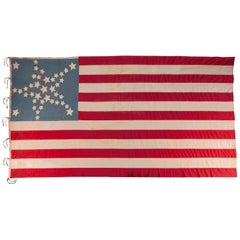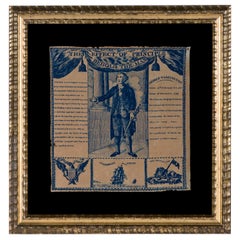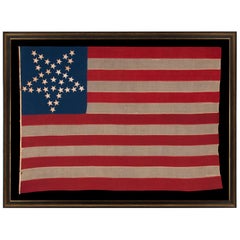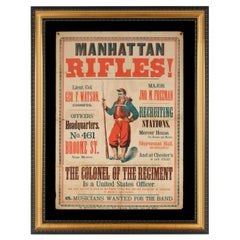19th Century Political and Patriotic Memorabilia
73
to
73
73
73
73
2
1
73
38
21
14
1
2
9
1
3
3
63
37
18
7
6
68
67
2
1
1
Period: 19th Century
Recognized Seller Listings
34 Star American flag, Updated to 39 Stars, with Stars in a Great Star Pattern
Located in York County, PA
34 STARS IN A WHIMSICAL RENDITION OF THE GREAT STAR PATTERN, ON A CIVIL WAR PERIOD FLAG WITH A CORNFLOWER BLUE CANTON, UPDATED TO 39 STARS IN 1876
34 star American national flag with additional stars added and one of the most stunning graphic designs I have ever seen in early flag-making. The original pattern was comprised of a circle of 5 large stars, and triangular arms made of smaller stars. These are noticeable pointy and bent like the arms of a starfish. Made of cotton, the stars are hand-sewn and double-appliquéd to a fantastic, cornflower blue canton, a color common to Civil War uniforms...
Category
American Antique 19th Century Political and Patriotic Memorabilia
Materials
Cotton
1806 Printed Linen Kerchief Glorifying George Washington, Germantown, Penn
Located in York County, PA
EXTRAORDINARILY EARLY (1806) PRINTED LINEN KERCHIEF GLORIFYING GEORGE WASHINGTON, PRINT WORKS, GERMANTOWN, PENNSYLVANIA
Printed in blue ink on coarse, white linen, this patriotic kerchief shows a standing portrait of George Washington, above which is a swag valance and the words “The Effect of Principle, Behold the Man”. The portrait is based on a mezzotint after Gilbert Stuart’s very famous painting of Washington in his later years, most often referred to as the Landsdowne portrait. Stuart painted three versions of it in oil on canvas, one of which was completed in 1796 for a wealthy merchant by the name of William Constable, who commissioned the work for Alexander Hamilton.
The kerchief is interesting because it is both American-made and documented. This is exceptionally unusual for any printed textile of the 19th century or prior and the earlier the time period the more unlikely an object is to be identified. This kerchief and a companion piece entitled “The Love of Truth Mark the Boy” (also glorifying Washington, through the fabled story of the cherry tree), were made circa 1806 by Germantown Print Works in Germantown, Pennsylvania.
To the left of Washington's image is a portion of his infamous farewell address to his troops at the end of the Revolutionary War. To the right is a short excerpt from his eulogy. Below these are three images. In the center is a square-rigged tall ship with “Commercial Union” above it, flanked by the American eagle on the left and the British lion on the right. It is reasonable to assume that the textile may have been produced in demonstration of the maker's desire, and/or that of others, to advance trade with England. Commercial printers were very influential in early America, as they possessed the means by which to disseminate information.
This kerchief and its companion piece are documented in Threads of History, Americana Recorded on Cloth, 1775 - the Present, by Herbert Ridgeway Collins (1979, Smithsonian Press), p. 63, items 38 & 39.* The two pieces pictured are in the collection of Cornell University, but the Collins text also cites an uncut pair to be present in the collection of the Western Reserve Historical Society, Cleveland, OH. The name "Germantown Print Works" is printed on the Western Reserve examples. Another example of the textile in question is documented in "Running for President, The Candidates and Their Images, 1789-1896" by Schlesinger, Israel, and Frendt, (1994, Simon & Schuster), p. 15.
I have seen three different color variations of this textile, including sepia, mulberry red, and blue. This particular example has a hand-sewn binding along the top, lower, and left edges.
Mounting: The textile was mounted and framed within our own conservation department, which is led by expert staff. We take great care in the mounting and preservation of flags and have framed thousands of examples.
The gilded molding has a rippled profile and dates to the period between 1825 and 1850.The background is 100% cotton twill, black in color. The glazing is U.V. protective plexiglass. Feel free to contact us for more details.
Condition: There is an all-over golden oxidation of the white fabric and there is very minor staining. There are tiny tack holes in each corner and there are minor nicks around the perimeter.
* Collins relates that Germantown Printworks was operated by the Hewsons. In doing so he cites one of Worthington Chauncey Ford's books on George Washington, but it isn't clear which one (there are many) and no page numbers are given. John Hewson was an Englishman who came to America and opened his printing business on the advice of Benjamin Franklin. He was one of the first “calico printers” and is the earliest documented to have advertised printed kerchiefs. His ads for bandanas appear as early as June 20th, 1774. He is suspected of having produced the very first American kerchief that pictured an American president, which is documented in Collins as item 1 on page 48. Linda Eaton, curator at Winterthur, in 2012, is currently doing in depth research on the three printers of fabrics that were operating in Germantown in early America. She discovered that the owner and/or operator of Germantown Print Works, while not currently known, was not John Hewson. This information is not yet published. She also noted that Winterthur possessed examples of the two George Washington textiles...
Category
American Antique 19th Century Political and Patriotic Memorabilia
Materials
Cotton
36 Star Antique Flag, Nevada Statehood, with Stars in the "Great Star" Pattern
Located in York County, PA
36 STARS IN THE "GREAT STAR" OR "GREAT LUMINARY" PATTERN, ON A MERINO WOOL FLAG OF THE CIVIL WAR ERA WITH BEAUTIFUL SCARLET AND ROYAL BLUE COLOR AND WITH ITS CANTON RESTING ON THE "WAR STRIPE," REFLECTS NEVADA STATEHOOD, 1864-67
36 star antique American flag of the Civil War era, with some rare, desirable, and beautiful features. The most obvious of these is the configuration of the stars. These are arranged in what is known as the “Great Star” or "Great Luminary" pattern, a star made out of stars, which is one of the most graphic and desired geometric designs among flag enthusiasts.
Nevada entered the Union as the 36th state on October 31st, Halloween, in 1864. Ushered in by Abraham Lincoln just eight days before the presidential election that resulted in his second term, the territory’s wealth in silver was attractive to a nation struggling with the debts of war and so increased support for the Republican ticket. The 36th star was officially added on July 4th, 1865, but since the flag makers generally cared very little about official star counts, the production of 36 star flags began much earlier. The makers of printed flags are known to have begun adding the 36th star as early as July of 1864, several months before the addition of Nevada actually occurred. This was a common practice during the late 19th century and is reflective of both the nation's desire for Westward Expansion and the hope of flag-makers to bring new star counts to market before their competitors. The 36 star flag was officially replaced by the 37 star flag in 1867, following the addition of Nebraska.
Great Stars come in many forms. This particular example has a single center star, surrounded by a pentagon of 5 stars, set inside its star-shaped perimeter. Note how the Great Star is positioned with two points up instead of one and so is effectively upside-down with respect to modern convention. Unlike the current flag, versions of the Stars & Stripes made during the 19th century and prior often displayed stars that were varied or completely random in their rotation on a vertical axis. Note how the feature draws attention and is unusual to the eye, in addition to being visually appealing.
Another interesting trait can be seen in the fact that the canton rests on a red stripe. When this scarce condition occurs, some flag historians have referred to it as the “blood stripe” or the “war stripe”, suggesting the flag was constructed in this manner when the nation was at war. In actuality, the placement probably occurred more often by accident. Not everyone knew where the canton was traditionally positioned, and because there was no official specification until 1912, there was no official placement. Whatever the case may be with regarding the reason, the war stripe feature is highly coveted by collectors.
The stars of the flag are hand-sewn, made of cotton, and are double-appliquéd (applied to both sides). The canton and stripes of the flag are made of fine merino wool. These are beautiful, luxurious fabrics with strong royal blue and scarlet color. Every seam was joined with a row of hand-stitching, then finished with a row of treadle stitching. Instead of employing the selvage edge of the red fabric, the top and bottom edges of the flag were turned under and seamed by hand and the fly end was seamed in the same fashion. There is a narrow binding along the hoist, treadle-sewn and made of cotton. Along this five cotton tabs were affixed, each with a tiny brass ring, which suggests that the flag was probably affixed to a wooden staff with twine or ribbon and hand-carried.
The name of "Stow" is inscribed along the hoist. This would be the name of a former owner.
In the field of early American flags...
Category
American Antique 19th Century Political and Patriotic Memorabilia
Materials
Wool
Colorful Civil War Recruitment Broadside for the "Manhattan Rifles"
Located in York County, PA
MASSIVE & COLORFUL CIVIL WAR RECRUITMENT BROADSIDE FOR THE "MANHATTAN RIFLES,” WHICH MUSTERED INTO 43RD AND THE 57TH NEW YORK INFANTRY DIVISIONS ...
Category
American Antique 19th Century Political and Patriotic Memorabilia
Materials
Paper
38 Star Parade Flag with Whimsical 6-Pointed Stars, Colorado Statehood
Located in York County, PA
38 WHIMSICAL STARS, WITH 6-POINTED PROFILES, SIMILAR TO THE STAR OF DAVID, ON AN ANTIQUE AMERICAN FLAG OF THE CENTENNIAL ERA; A REMARKABLE SPECIMEN, ONE-OF-A-KIND AMONG KNOWN EXAMPLE...
Category
American Antique 19th Century Political and Patriotic Memorabilia
Materials
Cotton
13 Star, 3rd MD Pattern, Hand-Sewn Antique American Flag, Civil War Era, 1861-65
Located in York County, PA
13 LARGE STARS WITH AN EVEN LARGER CENTER STAR, IN A CIRCULAR VERSION OF WHAT IS KNOWN AS THE 3RD MARYLAND PATTERN, ENTIRELY HAND-SEWN, MADE SOMETIME BETWEEN 1850 AND THE CIVIL WAR (...
Category
American Antique 19th Century Political and Patriotic Memorabilia
Materials
Wool
41 Stars In a Lineal Pattern With Offset Stars, Montana Statehood American Flag
Located in York County, PA
41 STARS IN A LINEAL PATTERN WITH OFFSET STARS THAT CREATE A CROSSHATCH IN THE CORNERS AND CENTER, ONE OF THE RAREST STAR COUNTS AMONG SURVIVING FLAGS OF THE 19TH CENTURY, REFLECTS MONTANA STATEHOOD IN NOVEMBER, 1889, ACCURATE FOR JUST 3 DAYS:
Numerous flags appeared with unofficial star counts in early America, produced by flag-makers in anticipation of the addition of more states. The 41 star flag...
Category
American Antique 19th Century Political and Patriotic Memorabilia
Materials
Cotton
34 Stars in an Outstanding Oval Medallion Configuration, Civil War Period
Located in York County, PA
34 STARS IN AN OUTSTANDING OVAL MEDALLION CONFIGURATION, ON A NARROW CANTON THAT RESTS ON THE 6TH STRIPE, ON A HOMEMADE, ANTIQUE AMERICAN FLAG OF THE CIVIL WAR PERIOD, ENTIRELY HAND-...
Category
American Antique 19th Century Political and Patriotic Memorabilia
Materials
Cotton
Patriotic Silk Kerchief w/ 34 Star Flags & an Image of Washington, Civil War Era
Located in York County, PA
PATRIOTIC SILK KERCHIEF OF THE CIVIL WAR PERIOD, WITH AN ENGRAVED IMAGE OF GEORGE WASHINGTON, CROSSED 34 STAR FLAGS, AN EAGLE, AND "UNION FOREVER" SLOGAN:
Patriotic kerchiefs that date prior to the 1876 Centennial of American Independence are rare among surviving 19th century textiles. Printed on silk and made during the opening years of the Civil War, this example consists of a white ground with red and blue borders. Inside is a prominent, copper engraved, device that consists of a large image of George Washington, crowned by a spread winged eagle that grasps a billowing streamer in its beak and talons. The ribbon boasts the Federal sentiment "Union Forever." The likeness of Washington is derived from Gilbert Stuart's Athenaeum portrait. Below this is a facsimile of Washington's signature, cradled by crossed American flags, each with 34 stars arranged in circular medallions.
Although political textile historian Herbert Ridgway Collins associated this kerchief with the centennial of American independence,* there is overwhelming evidence that it was produced earlier. The large scale is much more indicative of kerchiefs produced in the 1860's and prior. Made of silk, the binding is hand-stitched, which is also common of those produced before 1876. When these facts are added to the pro-Union Civil War slogan and flags in the 34 star count, the combination of all these factors points firmly to Civil War period manufacture. Kansas was admitted into the Union as the 34th state on January 29th, 1861, about two-and-a-half months before the Confederate assault on Fort Sumter that marked the beginning of the Civil War. The 34th star was officially added on July 4th of that year and the star count remained official until July 4th, 1863.
Further evidence can be found in an example of this kerchief that resides in the collection of the Adams County, Pennsylvania Historical Society, with firm provenance to a woman by the name of Emma Yount. The story goes like this: “With the Battle of Gettysburg looming and the countryside in turmoil, the Union cavalry rode into Gettysburg on the afternoon of June 30, 1863. The troopers dismounted and lounged in the town while awaiting further orders. During that time, the seven year old daughter of innkeeper Israel Yount, Emma, was playing outside their home when a cavalryman asked her to come and visit with him while he was resting. The cavalryman told her that he missed his young daughter at home and asked if little Emma would hug and kiss him on the cheek to remind him of his daughter, who he felt he might not ever see again. Emma asked her mother if she could do as the cavalryman suggested, and her mother considered the circumstances and allowed Emma to do so. Before leaving, the cavalryman gave young Emma a silk handkerchief he was carrying that featured George Washington's image and patriotic border and flags. Emma kept that handkerchief until her death in 1946 and it was then donated to the Adams County Historical Society.”
The trio of brass rings, hand-sewn along the top edge, would have been added by a former owner so that it could be hung vertically. The textile itself is both beautiful in design and rare. Outside of an example pictured by Collins in his book “Threads of History” (Smithsonian Press, 1979), and the copy in the Adams County Historical Society, only three others like it are known to have surfaced, including this example. This condition is excellent for the period and it survives as an exceptional relic of the War Between the States.
It is of interest to note that kerchief bears marked similarities to another, especially rare, pro-Union variety, that was produced in London for the American market. Notably larger in scale, but very much alike in terms of the fabric, the printing, the shades of red and blue, the verbiage, and the general overall graphic feel, it was produced by Foster & Porter, a known, English maker of printed kerchiefs. Instead of featuring George Washington, the imagery centers on a large cannon...
Category
American Antique 19th Century Political and Patriotic Memorabilia
Materials
Silk
Patriotic Scherenschnitte In the Style Often Attributed to Isaac Stiehly
Located in York County, PA
EXCEPTIONAL PATRIOTIC SCHERENSCHNITTE (PAPER CUTTING), IN THE STYLE OFTEN ATTRIBUTED TO ISAAC STIEHLY, ENTITLED “LIBERTY,” WITH IMAGERY THAT INCLUDES AN AMERICAN EAGLE WITH A 14 STAR, 14 STRIPE FLAG IN ITS BEAK, A RATTLESNAKE, LOVE BIRDS, AND EAGLES ON URNS, CA 1830-1850
This exceptional patriotic scherenschnitte was executed in the style often attributed to Pennsylvania German minister Isaac Stiehly (1800-1869). Scholars now agree that one or more artists, working in New York, were producing their own work in a very similar style. Several examples are known that bear the names of New York and/or New Jersey residents, while two, in particular, include text that celebrates the 1844 New York mayoral election victory of publishing magnate James Harper [founder of what is now Harper Collins], who ran on a ticket sponsored by the American Republican Party, a nativist organization concerned with the loss of American jobs to Irish immigrants.
Note the quality of the cutwork on this example, the centerpiece of which is a large American eagle, gripping a coiled rattlesnake and holding an American flag in its beak. Above, in a lozenge-shaped medallion, the word "Liberty" is executed in large script. To the left and right of this are elaborately decorated ovals, and anchoring each corner of the work are snowflake-like medallions.
To each side of the eagle, and below, is a plethora of flora and fauna, the outermost pillars of which are supported by two urns, decorated with eagles. At the bottom center is a diamond within a heart, with two doves, one of which is offering the other a leaf. Above this there are appear to be crude representations of a gnome and a fairy flanking and urn decorated with another heart, from which grow the vines in the center window. Interlocking rings decorate the border, probably to represent marriage, and it can logically be presumed that the scherenschnitte was a wedding gift.
It is of interest to note that the flag displays both 14 stars and 14 stripes. Although the reason for the use of this count is unknown, on the surface it does appear to be intentional. Other known patriotic scherenschnitte display flags with various star and stripe counts. Of those I have personally owned, the one bore 14 stars and 13 stripes, another 11 stars and 13 stripes, another displayed two flags, including a 12 star flag with 14 stripes and a 14 star jack (a blue naval flag with stars but no stripes), and another, also with 2 flags, displayed a 20 star flag...
Category
American Antique 19th Century Political and Patriotic Memorabilia
Materials
Paper
13 Hand-Sewn Stars, In an Oval Version of the 3rd Maryland Pattern
Located in York County, PA
13 HAND-SEWN STARS, IN AN OVAL VERSION OF THE 3RD MARYLAND PATTERN, ON AN ANTIQUE AMERICAN FLAG MADE IN THE PERIOD BETWEEN THE CIVIL WAR (1861-65) AND THE 1876 CENTENNIAL OF AMERICAN...
Category
American Antique 19th Century Political and Patriotic Memorabilia
Materials
Wool
Hand-Painted 19th Century Banner with the 1867 Proposed Seal of Illinois
Located in York County, PA
HAND-PAINTED 19TH CENTURY BANNER WITH AN 1867 VERSION OF THE SEAL OF THE STATE OF ILLINOIS, PROPOSED IN THAT YEAR BY THE SECRETARY OF STATE, BUT IN A VARIATION NEVER FORMALLY ADOPTED
Banner with the Illinois State Seal, in a rare variation of the design, never adopted. In 1867 Illinois Secretary of State Sharon Tyndale proposed that the phrases in the state motto be reversed. In the wake of the Civil War, (which ended in 1865,) Tyndale suggested that the verbiage be changed from "State Sovereignty--National Union" to "National Union--State Sovereignty,” which made sense given the recent secession of the Southern States, which placed their own interests first. Illinois' own Abraham Lincoln had worked hard to preserve national interests, echoed here in the altering of the language. Though Tyndale’s suggestion was rejected, he was nonetheless charged with creating a new design, which he did and was soon adopted. This displayed the dates of "1818," when Illinois became a state, and "1868," when the seal was officially changed. Interestingly enough, Tyndale did manage to send a message in the new version by turning the word “sovereignty” upside-down , with the surmised explanation that this fit accordingly with the orientation / position of the streamer.
The banner is beautifully hand-painted on muslin and retains its original staff. The shape is beautifully scalloped at the bottom edge, which is painted to look as if there is an applied fringe. Most of the elements are congruent with the 1868 version, but there are various differences. Set within a shield-shaped medallion—usually circular—is the expected eagle in a side view, spread wing pose with beak uplifted. The eagle is supposed to be perched upon a rock with one talon, while gripping a Federal shield in the other. Here there is no rock and both talons grip the shield, which displays 13 stars. Note the date of "1867" and Tyndale's preferred order of the wording on the billowing ribbon in the eagle's beak. The foreground of the official design is all grass. Here there are olive branches—a peacetime reference appropriate for a country recovering from war—on a grassy area, set upon a sandy shore before Lake Michigan, with a rising sun on the horizon.
Mounting: The banner was mounted and framed within our own conservation department, which is led by masters degree trained staff. We take great care in the mounting and presentation of flags and have preserved thousands of examples; more than anyone worldwide.
The background is 100% cotton twill, black in color. The mount was placed in a black-painted, hand-gilded and distressed Italian molding. A shadowbox was created to accommodate the staff. The glazing is U.V. protective plexiglass. Feel free to contact us for more details.
Banner - 49" x 56.5"
Frame - 67.75" x 59.25"
About Jeff R. Bridgman Antiques, Inc.:
As an advisor to top museums and collectors alike, Jeff Bridgman is the world's leading expert and source for antique American flags and political textiles...
Category
American Antique 19th Century Political and Patriotic Memorabilia
Materials
Cotton
Hand-Painted Patriotic Banner With The Seal of the State of Illinois
Located in York County, PA
HAND-PAINTED PATRIOTIC BANNER WITH THE SEAL OF THE STATE OF ILLINOIS AND GREAT FOLK QUALITIES PROBABLY MADE FOR THE 1868 DEMOCRAT NATIONAL CONVENTION...
Category
North American Antique 19th Century Political and Patriotic Memorabilia
Materials
Canvas
Hand-Painted Patriotic Banner with the Seal of the State of Oregon
Located in York County, PA
HAND-PAINTED PATRIOTIC BANNER WITH THE SEAL OF THE STATE OF OREGON AND GREAT FOLK QUALITIES, 1861-1876:
Swallowtail format, patriotic vertical banne...
Category
American Antique 19th Century Political and Patriotic Memorabilia
Materials
Canvas
Hand-Painted Patriotic Banner with the Seal of the State of Virginia
Located in York County, PA
HAND-PAINTED PATRIOTIC BANNER WITH THE SEAL OF THE STATE OF VIRGINIA AND GREAT FOLK QUALITIES:
Swallowtail format, patriotic vertical banner beari...
Category
Antique 19th Century Political and Patriotic Memorabilia
Materials
Canvas





